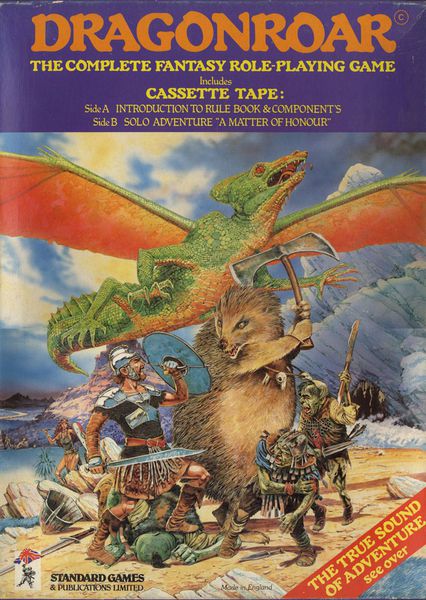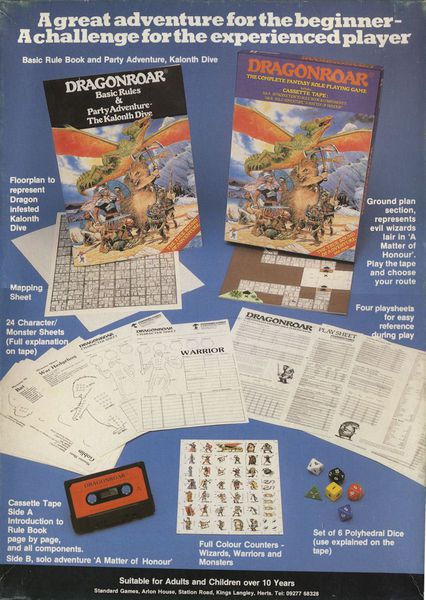I started to feel that I didn’t know roleplaying games well enough so I came up with the plan to read a roleplaying game corebook for every year they have been published. Selection criteria is whatever I find interesting.

I had a lot of options for the game to read for 1985. The first edition of Pendragon. The cult classic Teenage Mutant Ninja Turtles & Other Strangeness. However, all of them paled before the allure of Dragonroar!
Dragonroar presents my reading project with a whole slew of firsts:
First non-American roleplaying game. Dragonroar is an early example of British roleplaying game design.
First game to feature WAR HEDGEHOGS, honourable and tough enemies who can savage a warrior by backing into them! See the cover, above.
FIRST GAME TO FEATURE A C-CASSETTE! Also to my knowledge the only game to ever do so.

Dragonroar is an introductory fantasy roleplaying game. The basic elements are familiar: Warriors and wizards, fighting monsters, boardgame-style dungeon adventures.
The uniqueness of Dragonroar doesn’t come through in the basic system or setting. It’s in the margins, the details and the framing. The C-cassette contains an introduction to the game mechanics on one side and a solo adventure on the other. What’s more, it introduces the listener to an in-game prog band, suggesting much more about the nature of the game world than any of the textual setting material. Except maybe the mention of a character called Arkan of Disiboth, “the Textual Pervert”, so called because of his mistranslations of holy texts.
One interesting detail is the section on gender in the chapter “Creating a character”. It’s the second section in the chapter, immediately after character name. It gives players three options: Play men, women, or “hermaphrodites or asexuals”. Today, the framing comes across as transphobic, but I’d still argue that presenting such options at all, especially in an introductory fantasy game, was unusual in 1985.
Gender pops up in Dragonroar in another place as well. The game features three participant roles: The Fatemaster (the GM), the player and the Arbiter. The Arbiter is a member of the player group who’s job is to make final decisions in case the players can’t agree on a course of action. The game says that: “playtests have shown that women make the best arbiters”.
Although most of the system revolves around movement and combat, one flourish is the mechanism for knowledge. Knowledge “specialisms” are divided into categories and you get more if you’re smarter and more experienced. Some of them are typical, such as Magic and Combat. However, Humanities is also a category and features the subcategory of Sociology, with the sub-sub-category of Women.
Thus, if you really squint, in Dragonroar you could play an asexual Women’s Studies major using the core rules. Although you’d still have to decide whether you were a Warrior or a Wizard. In some respects, the binary is inescapable.
Dragonroar is a great example of how the perception of a game changes with context. According to some of the contemporary reviews I saw, Dragonroar didn’t get a great reception. I can understand why: The mechanics are a muddle and the book spends a surprising amount of time bashing players of other roleplaying games for playing wrong.
Nevertheless, when I read this in 2019, I don’t really care about the core of the game because it would have been outdated anyway. I care about unique ideas, and on that front Dragonroar delivers. The experience of listening to the C-cassette on an old cassette player I was able to scrounge up was surprisingly magical, probably more now than when the game was new.